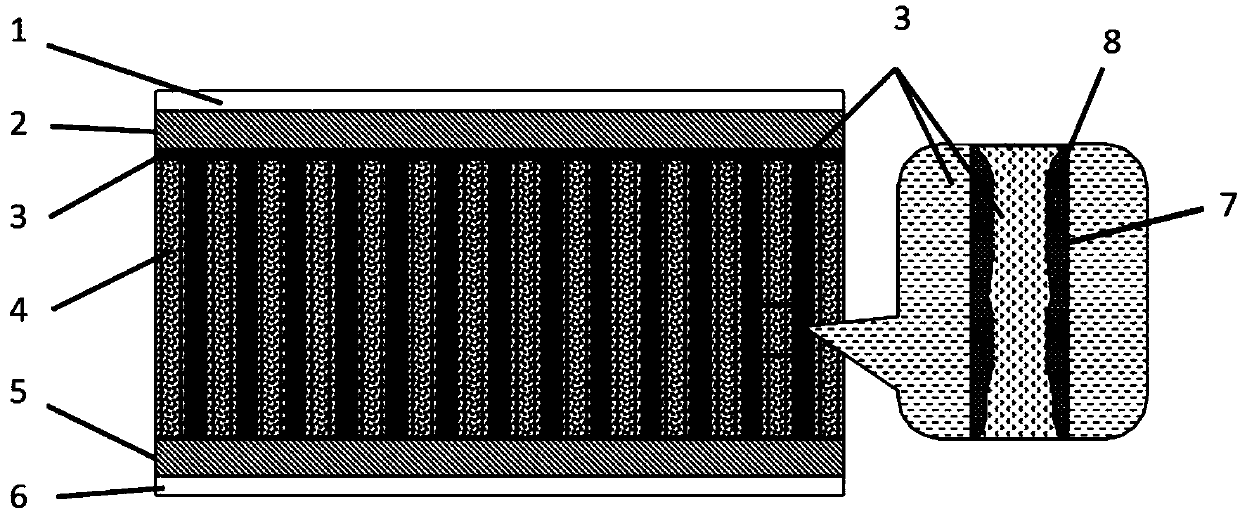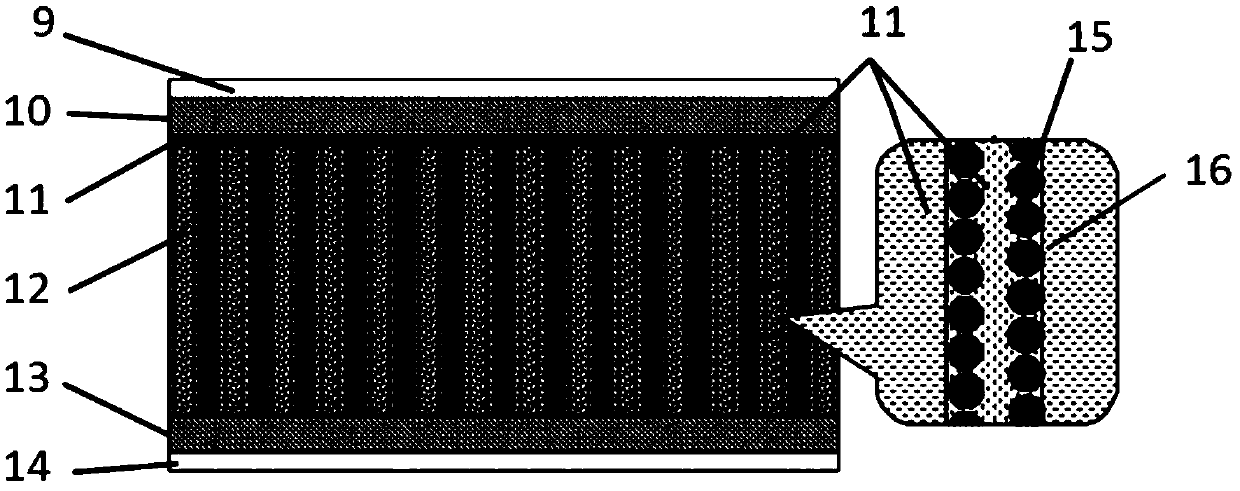Tritium-based nanotube isotope battery
A technology of isotope batteries and nanotubes, applied in nanotechnology, nanotechnology, nanotechnology for materials and surface science, etc., can solve problems such as high production costs, low utilization efficiency of radiation sources, and unsatisfactory engineering applications , to achieve the effect of improving utilization rate, improving energy conversion efficiency and reducing recombination rate
- Summary
- Abstract
- Description
- Claims
- Application Information
AI Technical Summary
Problems solved by technology
Method used
Image
Examples
Embodiment 1
[0039] An embodiment of the tritium-based nanotube isotope battery of the present invention, such as figure 1 As shown, from top to bottom are the cover plate 1 of the top electrode, the top electrode 2, the isotope radiation source 3, the wide bandgap semiconductor nanotube layer 4, the substrate electrode 5 and the bottom plate 6 of the substrate electrode.
[0040] The wide bandgap semiconductor nanotube layer 4 described in this embodiment is provided with a plurality of nanotubes 7, and the plurality of nanotubes 7 are arranged parallel to each other, and the surface of the wide bandgap semiconductor nanotube layer 4 uses graphene 8 as a heterogeneous material Surface modification; the material of the wide bandgap semiconductor nanotube is titanium dioxide, the material of the substrate electrode is conductive glass, the material of the top electrode is metal foil, and the isotope radiation source is a compound of tritium and graphene.
[0041] The preparation method of t...
Embodiment 2
[0048] An embodiment of the tritium-based nanotube isotope battery of the present invention, such as figure 2 As shown, from top to bottom are the cover plate 9 of the top electrode, the top electrode 10, the isotope radiation source 11, the wide bandgap semiconductor nanotube layer 12, the substrate electrode 13 and the bottom plate 14 of the substrate electrode.
[0049] The wide-bandgap semiconductor nanotube layer 12 described in this embodiment is provided with a plurality of nanotubes 16, and the plurality of nanotubes 16 are arranged parallel to each other. The surface of the wide-bandgap semiconductor nanotube layer 12 uses noble metal gold 15 as a heterogeneous material. Surface modification; the material of the wide bandgap semiconductor nanotube is titanium dioxide, the material of the wide bandgap semiconductor nanotube is titanium dioxide, the material of the substrate electrode is conductive glass, and the top electrode material is metal foil. The isotopic radia...
Embodiment 3
[0057] Such as image 3 As shown, multiple tritium-based nanotube isotope batteries described in Example 1 are connected in series to realize multi-unit multi-layer stacking integrated packaging, mainly including external load 17, storage capacitor 18, wide bandgap semiconductor nanotube isotope battery Unit 19 and external wires 20.
[0058] Such as Figure 4 As shown, multiple tritium-based nanotube isotope batteries described in Example 1 are connected in parallel to realize multi-unit multi-layer stacking integrated packaging, mainly including external load 21, storage capacitor 22, wide bandgap semiconductor nanotube isotope battery Unit 23 and external wire 24.
[0059] The specific method of the cascade packaging of the tritium-based nanotube isotope battery is as follows: the tritium-based nanotube isotope battery described in Example 1 is used as a unit, and multiple groups of units are stacked and packaged sequentially. Defining the uppermost and lowermost electro...
PUM
| Property | Measurement | Unit |
|---|---|---|
| Diameter | aaaaa | aaaaa |
| Length | aaaaa | aaaaa |
| Thickness | aaaaa | aaaaa |
Abstract
Description
Claims
Application Information
 Login to View More
Login to View More - R&D
- Intellectual Property
- Life Sciences
- Materials
- Tech Scout
- Unparalleled Data Quality
- Higher Quality Content
- 60% Fewer Hallucinations
Browse by: Latest US Patents, China's latest patents, Technical Efficacy Thesaurus, Application Domain, Technology Topic, Popular Technical Reports.
© 2025 PatSnap. All rights reserved.Legal|Privacy policy|Modern Slavery Act Transparency Statement|Sitemap|About US| Contact US: help@patsnap.com



